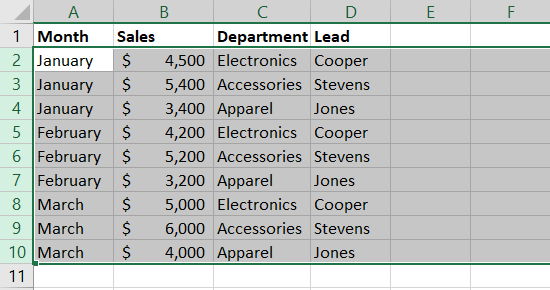
Step-by-Step Guide: How to Create Dynamic Summaries by Grouping/Collapsing Excel Rows

Step-by-Step Guide: How to Create Dynamic Summaries by Grouping/Collapsing Excel Rows
Quick Links
- How to Group Rows in Excel
- How to Collapse a Grouped Row
- How to Use Subgroups, Additional Groups, and Subtotals
- How to Ungroup Rows in Excel
Key Takeaways
Select the rows you want to group and go to the Data tab. In the Outline drop-down menu, select “Group.” Use the plus (+) and minus (-) or number buttons that appear to collapse and expand each group.
Viewing only the data you want to see can be tedious when you’re working with a large spreadsheet. Luckily, Excel offers various tools you can use to simplify your data. For example, you can easily group rows in Excel and then collapse or expand your data as needed.
How to Group Rows in Excel
To group by rows in Excel, start by selecting the adjacent rows you want to use. You can do this by dragging your cursor through the row headers or by selecting the first row, holding Shift, and then selecting the last row in the range.

Go to the Data tab and select the Outline drop-down arrow. Pick “Group” in the menu.

You’ll then see your selected rows grouped together, ready to be collapsed and expanded when you need them to be.
How to Collapse a Grouped Row
Note the buttons on the left side of your grouped rows. You’ll use these buttons to collapse and expand your group.

To collapse the group, click the minus (-) sign or button 1. To expand the group again, click the plus (+) sign or button 2.

How to Use Subgroups, Additional Groups, and Subtotals
You can create more than one group in a sheet. You can also create subgroups or use the subtotal feature to both group and add calculations .
To create a subgroup, expand the parent group and then follow the same steps as above to select and group rows.

When you create the subgroup, you’ll see another level of plus (+) and minus (-) buttons and an additional button labeled 3.
You would then use the second set of plus (+) and minus (-) buttons along with buttons 1, 2, and 3 to collapse or expand the entire group and subgroup.

To create another group in the sheet, follow the same steps as earlier.

Keep in mind that you can’t create two groups adjacent to one another or Excel will put them into the same group. Be sure to leave a row between groups or use the above subgroup option.
To create groups and subtotal them at the same time, select all rows you want in the group. Go to the Data tab and pick “Subtotal” in the Outline drop-down menu.

Use the options in the Subtotal window to choose the grouping, function for the calculation , and which column to use for the figures. Mark any additional options you want and click “OK.”

You’ll then see your rows grouped and calculated as you instructed. Plus, you’ll have an overall total at the bottom for whatever function you selected. For example, you may see Grand Total, Grand Average, or similar.

How to Ungroup Rows in Excel
If you want to remove the grouping you’ve created, you can do so for both groups and subgroups.
Related: How to Add and Remove Columns and Rows in Microsoft Excel
Select the group by dragging through the rows . Go to the Data tab, select the Outline drop-down arrow, and pick “Ungroup.”

You’ll then see the group return to its original view.

You can also use the Ungroup option to remove only certain rows from a group. For example, if you have rows 2 through 10 in a group but want to remove rows 8 through 10, you can do so.
Select the rows you want to remove from the group. Then, select Outline > Ungroup on the Data tab.

Those rows are then removed from the group while the rest of the rows remain in it.

You can then collapse and expand your remaining group without affecting the rows you removed.

If you want to group rows in Excel for easier viewing, try the grouping feature in your spreadsheet.
For more, check out how to insert multiple rows or how to move rows in Excel .
Related: How to Create an Automatic Outline in Microsoft Excel
Also read:
- [New] 2024 Approved Elevate Presentations with Melodic Additions
- [New] 2024 Approved The Allure vs Warnings of Virtual Reality Worlds
- [Updated] In 2024, Dominating Discussion Topics in the Social Space
- Conquering FS Issues: A Win11 Manual Approach
- Decoding High-Performance Tech: Go With Windows, Not Linux
- How to Make the Most of Your iPhone 7 Plus Lock Screen with Notifications?
- How to Manage Win 10’S Online Threat Detection System
- How to Unlock Xiaomi Redmi Note 12 5G Phone Password Without Factory Reset?
- Mastering the Shutdown: Windows 11'S Disabling Techniques
- Mastering Wallpaper Shifts on a Windows PC
- Mastering Your Dell Inspiron's Factory Reset Functionality with Our Complete Guidance
- Navigating the Shift From Windows Terminal’s Deep Dive to Relaxed Browsing
- Overhauling Inoperative Alerts for Phone Link App in Windows
- The Future of Notes Is Obsidian Canvas Style
- Tips How to Quickly Enjoy Instagram Videos
- Unlicensed, Yet Lawful Music Repositories (Games)
- Unveiling the Finest Free Upgrades to Optimize Windows Cars
- Unveiling the Strengths: In-Depth Analysis of the Sony PlayStation 5
- What Makes A Good Video Coder for Use on Windows Systems?
- Title: Step-by-Step Guide: How to Create Dynamic Summaries by Grouping/Collapsing Excel Rows
- Author: Richard
- Created at : 2024-12-03 00:57:05
- Updated at : 2024-12-06 16:41:39
- Link: https://win11-tips.techidaily.com/step-by-step-guide-how-to-create-dynamic-summaries-by-groupingcollapsing-excel-rows/
- License: This work is licensed under CC BY-NC-SA 4.0.